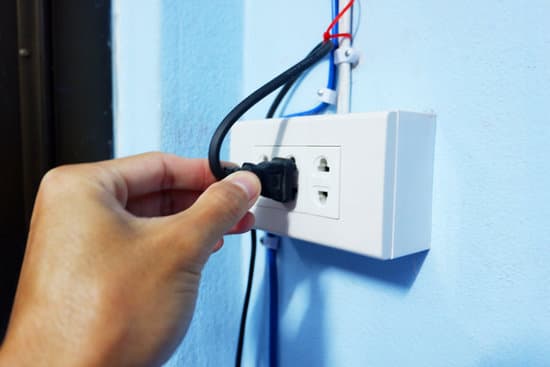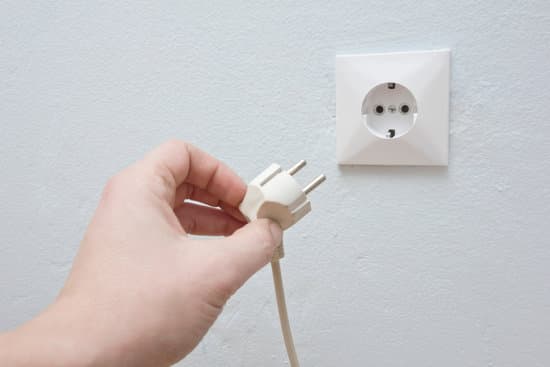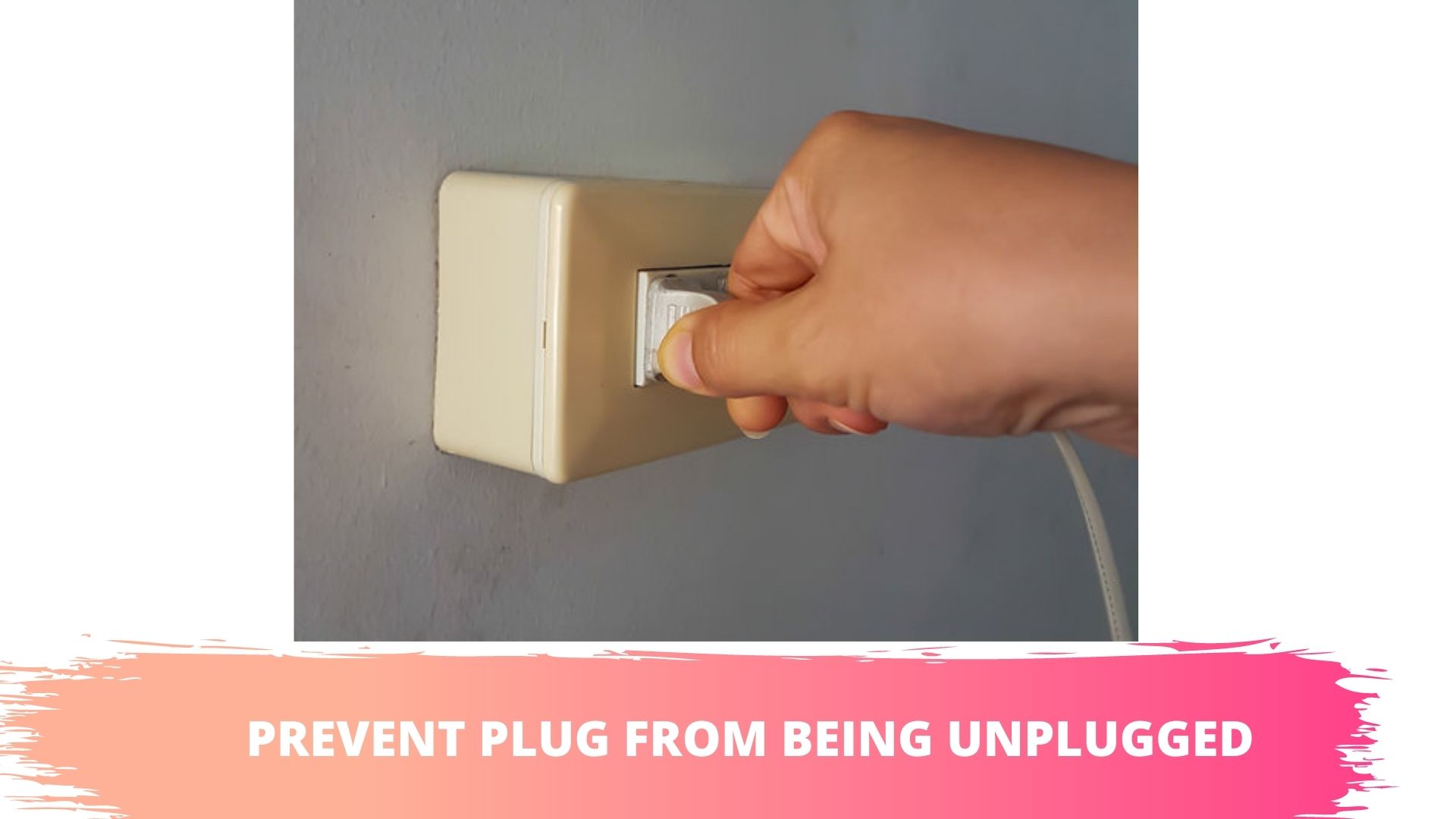This sounds like a ridiculous question but it makes sense if you have children. Because they are so inquisitive, they may pull your plug out of its socket without stopping to understand the consequences. Adults do this as well. They will unplug appliances without taking a moment to figure out whether or not the appliance in question has a sophisticated shutdown process that must be executed before you disconnect it from power.
Preventing Plug From Being Unplugged
If you want to prevent a plug from being unplugged, try these simple, straightforward solutions:
1). Use Lock-In Plug
People think that all plugs are the same but that isn’t true. Some plugs are much harder to unplug than others. One example is the Lock-In Plug. It is a plug that locks into place when you attach it to an outlet.
It comes with a hook that keeps it secure. To remove the plug, you have to press the release button. An adult that doesn’t know about this button won’t know how to remove this plug. You can also trust it to confuse children.
You don’t have to restrict yourself to this brand. These products are very useful in sensitive situations where the consumer cannot afford to have their power cord unplugged. People use them for everything from vacuums and refrigerators to computers and security systems. For that reason, it won’t take you long to find a locking plug on the market. There are plenty to choose from.
2). Use Covers
Many parents are aware of plastic outlet plugs because the items are used to cover outlets, preventing their children from sticking metal objects into the slots. The people at Top Tech Electric don’t like them because they are a choking hazard that is just as likely to break off inside the outlet.
But many parents still use them. If your only objective is to prevent people from unplugging your appliances, don’t be so quick to ignore these covers. Some of these products protect both the outlet and the plug.
Consider this Dreambaby Plug and Outlet cover. Not only does it keep children from tampering with the outlet but it prevents them from removing the plugs.
3). Use Outlet Boxes
Like outlet covers, some people do not fully appreciate the benefits of outlet boxes. Because of their name, many consumers think that their only objective is to protect the outlet but that isn’t true.
According to MomLovesBest, outlet boxes have room for your plug. In other words, once you close them, they will keep both the outlet and the plug out of reach, preventing individuals that are unfamiliar with the 2-button release system from removing the plug. Outlet boxes are normally used to protect outdoor outlets but no one will stop you from using them inside.
How to Stop Someone Unplugging Plugs?
If you don’t want a child or even an adult to accidentally pull a plug out of its socket, outlet boxes, covers, and locking plugs will prevent them from doing so.

However, if an adult is trying to intentionally unplug a plug, you have no way of definitively stopping them. Most adults can understand and undo the mechanisms keeping a locking plug in place. They can also pull outlet covers and boxes off.
The best you can do to stop a determined adult is to attach the plug to a socket in a difficult location, for instance, behind a heavy appliance or furniture. If you push the heavy appliance or furniture against the plug, it will keep them from unplugging the plug, unless they are determined enough to find someone that can help them to remove the obstacle.
Why Should Electrical Connections Not Be Unplugged By Pulling The Cord?
Pulling the cord will expose the wires. This practice may also break the wires. This can lead to fires and electrocutions. You are supposed to hold the plug itself, not the cord. If you have to pull the cord, especially in an emergency, try pulling it straight out.

Don’t jerk it out. Apply steady force. If your cable is strong enough, the cord may survive. But in an ideal situation, you should never do this, no matter how strong your cable is.
Hydro Quebec is quite adamant about this issue. They do not want consumers to unplug a device by pulling the cord. The connection between the plug and the cord is one of the weakest parts of the cable.
How To Lock The Plug Into An Outlet?
The easiest way is to use a locking plug. You can also use locking receptacles.
An outlet that won’t hold its plug is dangerous. Not only is it a fire risk but it can cause arcing. More importantly, loose outlets are not reliable. You cannot trust them to power or charge your devices. If your outlet cannot hold its plugs, the only option is to replace it. Don’t bother trying to fix it.
These situations only develop when an outlet’s contact points wear out as a result of age, heat, and sparks. You can’t fix them. If you don’t have the option of replacing the outlet, you can keep the plug from falling out by using a socket saver or an electric cord holder. You can also use tape. Though, this should be a temporary solution.
Is It Safe To Tape A Plug Into An Outlet?
Yes, it is safe. Tape isn’t particularly conductive, so it doesn’t introduce any electrocution hazards. However, this should be a temporary solution.
Outlet Won’t Hold Plug – Why?
Many outlets are unable to hold the plug because the contact points are either damaged or they are worn out.
An outlet that won’t hold a plug is dangerous because it exposes the prongs to moisture. It also encourages arcing, which is a danger to you. Fortunately, if you keep reading, you will realize that there are ways to deal with loose outlets.
How To Fix An Outlet That Won’t Hold A Plug?
Outlets become loose when their contact points wear out as a result of age, heat, sparks, and the like. Once this happens, your only option is to replace the receptacle. The process involves the following:
1). Start by switching the power off. Use a multimeter to ensure that the outlet is inactive. You ran the risk of electrocuting yourself by replacing the receptacle when the power is on.
2). Remove the cover of the outlet and take the receptacle out. This is a simple matter of removing the screws.
3). Detach the wires. Take a moment to check for signs of burnt or melted wires. If everything is fine, you can go ahead and attach a new receptacle to the wires.
There is no point in trying to fix worn-out contact points. The safest option is to get a new outlet.
How To Keep Plugs From Falling Out of Sockets?
If you don’t own your home, or if you have to plug your device into an outlet in a public area, you don’t have the option of replacing the loose outlet. In such situations, you can use the following steps to keep your plug from falling out:

1). Try pressing the prongs of the plug towards one another. Apply enough pressure to realign them without breaking them. In some cases, once you push the plug into the loose socket, it will hold, at least for a time. This method is more likely to work with 2-prong plugs.
2). You can use a plastic sleeve called a socket saver that you can push into the outlet to ensure that the cord stays in place once you plug it in.
3). You can use tape to keep the plug from falling out. DOC Electric is worried that the practice may cause a fire. But you should be fine if you use electrical tape.
4). Try using an electric cord holder. As its name suggests, once you screw this plastic device into place above the outlet, it will hold the cord in place. This reduces the weight the cord exerts on the plug, making it less likely to fall out.
Conclusion
Can you prevent a plug from being unplugged? Yes, you can. There are plenty of devices that make this possible. One example is the locking plug. It has a hook that secures the plug. You can only pull it out by using the release button.
Another effective option is a cover that protects the outlet whilst also preventing other people, especially children, from pulling the plug out. Even more effective is the outlet box. It covers the entire outlet but it leaves room for the plug.
If all else fails, you can just push a big piece of furniture or an appliance against the plug. This will prevent people who cannot move these items from unplugging the plug. If you have decided to remove the plug yourself, make sure you hold the plug.
Don’t pull the cord. Doing so will break and expose the wires. This may cause a short circuit, start a fire, or electrocute the consumer.

